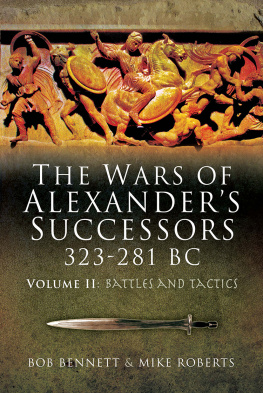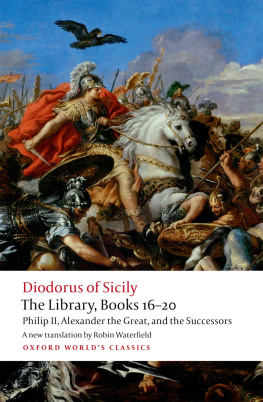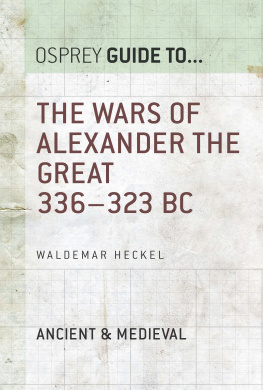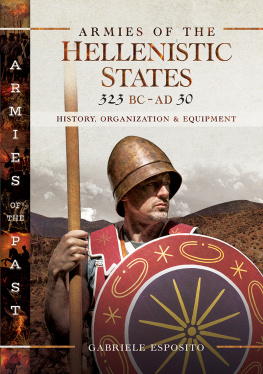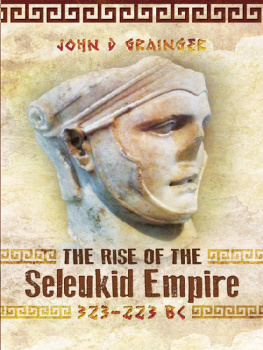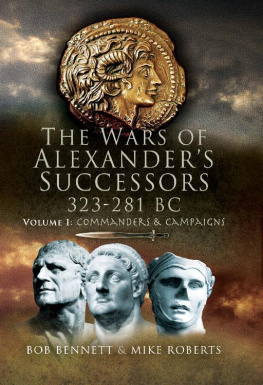Pagebreaks of the print version
Acknowledgements
As with our first volume, our thanks go out to the late Mr Polack (Bobs old teacher) for his translation of Polynaeus and to Jeff Champion without whom we would not have appeared in print. More specifically for this volume, we would like to thank again Phil Sidnell, our editor, who has been an invaluable source of help and guidance in both the planning and gestation of this book.
Since the publication of Volume 1 we have been touched and gratified by the support of our friends and work colleagues who have not only bought the book but appear to have actually read it and said many complimentary things as well. Finally our thanks go again to our wives Janet and Sue and children Katie, Joe, Philip and Stephen. After publication of Volume 1 they have been at last forced to take us seriously and their interest has concomitantly increased from the intermittent to the almost frequent.
Bibliography
Ancient Sources
Arrian, The Campaigns of Alexander , translated by A De Selincourt (London, 1958).
Asclepiodotus, Tactica , translated by the Illinois Greek Club, (London and Cambridge, Massachusetts, 1923).
Diodorus Siculus, Universal History VIII , translated by C.B. Welles (London and Cambridge, Massachusetts, 1963).
Diodorus Siculus, Universal History IX , translated by R. M. Geer (London and Cambridge, Massachusetts, 1947).
Diodorus Siculus, Universal History X , translated by R. M. Geer (London and Cambridge, Massachusetts, 1954).
Diodorus Siculus, Universal History XI , translated by F. R. Walton (London and Cambridge, Massachusetts, 1957).
Hypereides, Funeral Oration 10 translated by J.O. Burtt in Minor Attic Orators, II, Lycurgus, Dinarchus, Demades, Hypereides. (London and Cambridge, Massachusetts, 1954).
Livy, Rome and Italy , translated by B. Radice (London, 1982). Plutarch, Demetrius , translated by I. Scott-Kilvert and included in The Age of Alexander (London, 1973).
Plutarch, Eumenes translated by B. Perrin and included in Parallel Lives VIII (London and Cambridge, Massachusetts, 1919).
Plutarch, Pyrrhus , translated by I. Scott-Kilvert and included in The Age of Alexander (London, 1973).
Polynaeus, Stratagems , translated for the authors by B. Polack.
Polybius, The Rise of the Roman Empire , translated by I. Scott-Kilvert (London, 1979). Quintus Curtius Rufus, The History of Alexander , translated by J. Yardley (London, 1984).
Vitruvius, De Architectura , translated by M.H. Morgan (Harvard University Press, 1914).
Xenophon, Cyropaedia , translated by H.G. Dakyns (London, 1911).
Adams, W L, The Dynamics of Internal Macedonian Politics in the time of Cassander in Ancient Macedonia , 3 (1983) pp 230.
Adcock, F E, The Greek and Macedonian Art of War (Berkeley, 1967).
Anglim S, Jestice P G, Rice R S, Rusch S M and Serrati J, Fighting Techniques of the Ancient World 3000 BCAD 500 (Staplehurst, 2005).
Anson, E M, Alexanders Hypaspists and the Argyraspids in Historia , 30 (1981) pp 11720.
Ashton, N G,The Naumachia near Amorgos in 322 B.C. in ABSA , 72 (1977) pp 111.
Ashton, N G, How Many Penteris in GRBS , 20 (1979) pp 32742.
Ashton, N G, The Lamian War a False Start in Historia , 30 (1983) pp 117120.
Bar-Kochva, B, The Seleucid Army (Cambridge, 1976).
Bennett, B, and Roberts, M, The Wars of Alexanders Successors 32328 1 BC Volume 1: Commanders and Campaigns (Barnsley, 2008).
Billows, R A, Antigonos the One-Eyed and the Creation of the Hellenistic State (Berkeley, 1990).
Bosworth, A B, Eumenes, Neoptolemus and PSI 12.1284 in GRBS , 19 (1978) pp 22737.
Bosworth, A B, Conquest and Empire-The Reign of Alexander the Great (Cambridge, 1988).
Bosworth, A B, The Legacy of Alexander (Oxford, 2002).
Bugh, G R (ed.) The Cambridge Companion to the Hellenistic World (Cambridge, 2006).
Campbell, D B, Greek and Roman Artillery 399 BCAD 363 (Oxford, 2003).
Campbell, D B, Greek and Roman Siege Machinery 399 BCAD 363 (Oxford, 2003).
Campbell, D B, Besieged: Siege Warfare in the Ancient World (Osprey Publishing, 2006).
Cary, M, A History of the Greek World from 323 to 146 BC (London, 1951).
Devine, A M, Diodorus Account of the Battle of Paraitacene in Ancient World , 12 (1985) pp 7586.
Devine, A M, Diodorus Account of the Battle of Gabiene in Ancient World , 12 (1985) pp 8796.
Garoufalias, P, Pyrrhus King of Epirus (London, 1979).
Gardiner, R (ed.) The Age of the Galley; Mediterranean Oared Vessels since Pre Classical Times-Conways History of the Ship (London, 1995).
Green, P, Alexander to Actium (London, 1991).
Hammond, N G L and Walbank, F W, History of Macedonia vol.3 (Oxford, 1988).
Harding, P, From the end of the Peloponnesian War to the battle of Ipsus , Translated Documents of Greece and Rome, No 2 (Cambridge, 1985).
Hauben, H, Fleet Strength at the Battle of Salamis (306 B.C.)in Chiron , 6 (1976) pp 15.
Heckel, W, The Marshals of Alexanders Empire (London & New York, 1992).
Hornblower, J, Hieronymus of Cardia (Oxford, 1981).
Keegan, J, The Mask of Command (London, 1987).
Lane Fox, R, The Classical World (London, 2005).
Lock, R A, The Origins of the Argyraspids in Historia , 26 (1977), pp 373378.
Lund, H S, Lysimachus (London & New York, 1992).
Morrison, J S, Athenian Seapower in 323/2 BC : Dream and Reality in JHS , 107 (1987), pp 8897.
Rice, R S, The Peregrinations of the Queen: Technology Transfer in the Hellenistic World ( http://ccat.sas.upenn.edu/rrice/queen.html , 1996).
Sidnell, P, Warhorse, Cavalry in Ancient Warfare (London, 2006).
Tarn, W W, Hellenistic Military and Naval Developments (Cambridge, 1930).
Ueda-Sarson, L, Alexanders War Elephants in Slingshot , 227 (2003), pp 1922.
Warry, J, Warfare in the Classical World (London, 1980).
Williams, K, Alexandria and the Sea: Maritime Origins and Underwater Exploration (Tampa, 2004).
Chapter One
Soldiers and Armies
As with so many discussions involving the Diadochi everything seems to drag us back to Alexander one way and forward to the era of Rome on the other. We are drawn to the origin and the nemesis. To try and understand the armies the Successors deployed in their many wars, we must first try and understand the army that Alexander brought to Asia, because both were, by and large, Macedonian organizations. Changed certainly by experiences in Anatolia, Mesopotamia, Iran, Bactria, Sogdia and India, but subsequently only in the case of Seleucus armies were the changes probably more than skin-deep. Elephants, chariots and light troops seemed to dominate in his armed forces, as they marched west from the borders of India towards the climactic Battle of Ipsus in 301 BC , in a manner that was quite different from his rivals. The military establishments that we have good details for, fighting the great battles of 323 to 312 BC , performed as Macedonians in a manner that would have been all too familiar to Alexander and even Philip, his father. The armies and the Diadochis use of them was rooted in the invading host that Alexander led over the Hellespont in 334 BC and how that organization was used and developed in the years of conquest. What changes there were, between 323 and 281 BC , as the Hellenistic kingdoms shook themselves out, had more to do with the military problems the generals faced over those years, rather than any inherently different attitudes or approaches amongst the leaders and soldiers involved.
The core of both Alexanders armies and those of his Successors was the infantry phalanx, not always the battle winner but always the backbone. We know much of these units, not just from descriptions of their role in the creation of the Macedonian Empire but also because this formation exerted a fascination on generations to come, that stretched even down to Europe of the sixteenth and seventeenth centuries AD. If Machiavelli saw the Roman legion as the exemplar of his Florentine militia at the beginning of the sixteenth century, the cousins William Louis and Maurice of Nassau at the end of that century reformed the Dutch army based on ideas from Aelians Tactica , a work from the age of Trajan which discussed the place of the phalanx in the Macedonian war machine.

